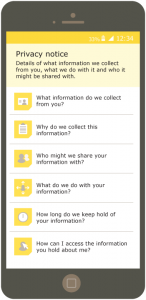
- Tietovaltuutetun toimisto on päivittänyt GDPR:n osion henkilön oikeudesta saada tietoa henkilötietojensa keräämisestä ja käytöstä.
Katsotaanpa uutta.
Joten me kaikki tiedämme tähän mennessä, että avoimuus on ytimessä GDPR. Salli henkilöiden pääsy hallussamme olevien henkilötietojen syvimpiin ja synkimpiin yksityiskohtiin, kerro, miten niitä käytetään, ja anna hallinta takaisin. Nyt GDPR menee syvemmälle tähän lupaukseen, ja siinä on oikeus saada tietoa.
GDPR:n artikloista 13 ja 14 löydät yksityiskohtaiset tiedot siitä, mistä henkilöille tulee tiedottaa – Information Commissioner's Office (ICO) kutsuu niitä tietosuojatietoiksi. Riippuen siitä, miten hankit tiedot alun perin (suoraan henkilöltä tai muun kolmannen osapuolen lähteestä), määrittää, mitä sinun on jaettava.
| Tiedot, jotka sinun tulee antaa | Yksityishenkilöiltä saadut henkilötiedot | Muista lähteistä hankitut henkilötiedot |
| Organisaation nimi ja yhteystiedot | ✓ | ✓ |
| Järjestön edustajan yhteystiedot | ✓ | ✓ |
| Tietosuoja Virkailijan (DPO) nimi ja yhteystiedot | ✓ | ✓ |
| Mitä aiot tehdä käsittelemillesi tiedoille | ✓ | ✓ |
| Onko sinulla laillinen peruste henkilötietojen käsittelylle? | ✓ | ✓ |
| Onko sinulla oikeutettu etu henkilötietojen käsittelyyn? | ✓ | ✓ |
| Saatujen henkilötietojen luokat | ✓ | |
| Henkilötietojen vastaanottajat tai vastaanottajaryhmät | ✓ | ✓ |
| Yksityiskohdat henkilötietojen siirroista kolmansiin maihin tai kansainvälisiin järjestöihin | ✓ | ✓ |
| Kuinka kauan aiot säilyttää henkilötietojasi | ✓ | ✓ |
| Yksityishenkilöiden oikeudet käsittelyyn liittyen | ✓ | ✓ |
| Oikeus peruuttaa suostumus | ✓ | ✓ |
| Oikeus tehdä valitus valvontaviranomaiselle | ✓ | ✓ |
| Henkilötietojen lähde | ✓ | |
| Yksityiskohdat siitä, onko henkilöillä lakisääteinen tai sopimusvelvoite toimittaa henkilötiedot | ✓ | |
| Yksityiskohdat automatisoidun päätöksenteon olemassaolosta, mukaan lukien profilointi | ✓ | ✓ |
Tässä on neuvoja, että otat huomioon tietojen alun perin keräämisen kontekstin ja käytä mahdollisuuksien mukaan samaa välinettä tietosuojatietojen välittämiseen. Ennen kaikkea on tärkeää pitää se selkeänä ja yksinkertaisena ja käyttää kieltä, jota kohdeyleisö ymmärtäisi.
Jos käytät esimerkiksi mobiili- ja älylaitteita, voit hyödyntää ponnahdusikkunoita, äänihälytyksiä ja laitteen eleitä. Lisäksi grafiikka ja kuvakkeet voivat auttaa paljon näiden tietojen välittämisessä yksinkertaisella ja intuitiivisella tavalla.
ICO viittaa myös "just-in-time-ilmoitukseen", jossa käyttäjälle esitetään asiaankuuluvaa ja kohdennettua tietoa henkilötietojen keräämisen yhteydessä tai kun hän päättää antaa suostumuksensa. Voit myös käyttää kerrostettua lähestymistapaa, joka on samanlainen kuin tämä mobiililaitteen kuva. Tärkeimmät ja ytimekkäät kohdat on lueteltu sekä lisätasoja tai linkkejä tarkempiin tietoihin muualla.
Yleisin tapa sallia yksilöiden pääsy ja valvonta miten heidän henkilötietojaan käytetään, on käyttää mieltymysten hallintatyökaluja tai hallintapaneelialueita verkkosivustolla.

Kuten olemme edellä todenneet, yksi henkilötietojen keräämisen vaatimuksista on varmistaa, että henkilöllä on pääsy tietoihin tietosuojatiedot samalla hetkellä. Jos olet saanut heidän henkilötietonsa toisesta kolmannen osapuolen lähteestä, sinun on noudatettava muita vaatimuksia:
Jos tietoja hankitaan toisesta lähteestä, GDPR ei kuitenkaan vaadi sinua kertomaan henkilöille mitään, mitä he jo tietävät. Tämä tarkoittaa, että tietosuojatietoja ei vaadita, jos:
Suorita tämä vaatimus oikein, niin et vain noudata monia GDPR:n näkökohtia, vaan se auttaa sinua myös osoittamaan sitoutuneemmalle asiakaskunnalle, että voit luottaa heidän henkilötietoihinsa.
ISMS.online sisältää henkilötietojen inventaario- ja tietueidenkäsittelyseurannan, joka auttaa sinua tekemään tämän.
Tämän blogin tiedot ovat yleisohjeita, eivätkä ne ole oikeudellisia neuvoja.
100 % käyttäjistämme saavuttaa ISO 27001 -sertifikaatin ensimmäistä kertaa